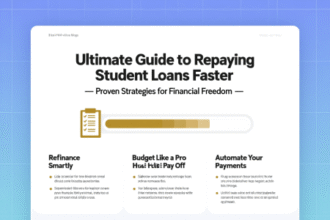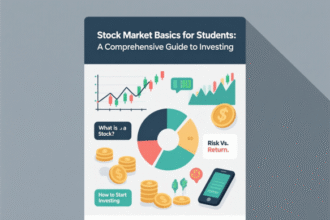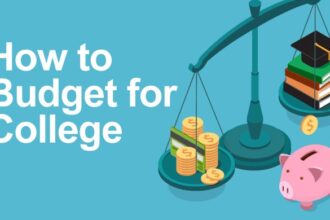In today’s fast-paced financial world, investing for students is no longer a distant concept reserved for seasoned professionals. With the rise of accessible financial tools, educational resources, and low-cost platforms, students can begin building wealth early, setting a strong foundation for their financial future. Starting to invest as a student offers unparalleled advantages, including the power of compounding, financial independence, and the ability to develop lifelong money management skills. This comprehensive guide explores actionable strategies, practical tips, and essential knowledge to help students embark on their investing journey confidently and effectively.
- Why Students Should Start Investing Early
- Understanding the Basics of Investing
- How to Start Investing as a Student
- Step 1: Set Clear Financial Goals
- Step 2: Create a Budget
- Step 3: Build an Emergency Fund
- Step 4: Choose an Investment Platform
- Step 5: Start Small and Stay Consistent
- Step 6: Educate Yourself Continuously
- Best Investment Strategies for Students
- Dollar-Cost Averaging
- Diversification
- Long-Term Investing
- Low-Cost Index Funds and ETFs
- Robo-Advisors for Hands-Off Investing
- Common Mistakes to Avoid When Investing as a Student
- Tax Considerations for Student Investors
- Resources for Student Investors
- Real-Life Examples of Student Investors
- Balancing Investing with Student Life
- The Role of Technology in Student Investing
- Ethical and Sustainable Investing
- Overcoming Financial Barriers as a Student
- The Psychological Benefits of Investing
- How to Stay Motivated
- Adapting to Economic Changes
- The Future of Investing for Students
- Recommendations and Suggestions
- Frequently Asked Questions (FAQs)
Why Students Should Start Investing Early
The earlier you begin investing, the more time your money has to grow. For students, this means leveraging the power of compound interest, which Albert Einstein famously called the “eighth wonder of the world.” By starting early, even small investments can grow significantly over time, thanks to the exponential growth that compounding facilitates.
The Power of Compound Interest
Compound interest allows your earnings to generate additional earnings over time. For example, investing $1,000 at an annual return of 7% could grow to over $7,600 in 30 years without additional contributions. For students in their late teens or early twenties, this time horizon is a massive advantage. By starting now, even modest investments can yield substantial returns by the time you reach retirement age.
-
Long Time Horizon: Students typically have decades before retirement, maximizing the benefits of compounding.
-
Small Investments Grow Big: Even $50 a month invested consistently can accumulate into a significant sum over time.
-
Risk Tolerance: Younger investors can afford to take calculated risks, as they have time to recover from market fluctuations.
Building Financial Independence
Investing early fosters financial discipline and independence. Students who invest learn to prioritize saving over spending, develop budgeting skills, and gain confidence in managing their finances. This independence reduces reliance on loans or parental support and creates a safety net for future expenses like graduate school, travel, or homeownership.
Learning Through Experience
Investing as a student provides hands-on experience with financial markets. Mistakes made with small sums early on serve as valuable lessons without catastrophic consequences. By experimenting with different investment strategies, students can refine their approach and build expertise over time.
Understanding the Basics of Investing
Before diving into investing for students, it’s crucial to understand fundamental concepts. Investing involves allocating money to assets with the expectation of generating a return. These assets can include stocks, bonds, mutual funds, real estate, or even cryptocurrencies. Each carries its own risk and reward profile, and understanding these is key to making informed decisions.
Types of Investments for Students
Students have access to a variety of investment vehicles, each suited to different goals, risk tolerances, and budgets. Below are some of the most accessible options:
-
Stocks: Represent ownership in a company. They offer high potential returns but come with volatility.
-
Bonds: Loans to governments or corporations that pay interest over time. They are generally safer but offer lower returns.
-
Mutual Funds: Pooled investments managed by professionals, offering diversification with lower risk.
-
Exchange-Traded Funds (ETFs): Similar to mutual funds but traded like stocks, often with lower fees.
-
Index Funds: A type of mutual fund or ETF that tracks a market index, like the S&P 500, ideal for beginners.
-
Robo-Advisors: Automated platforms that manage investments based on your goals and risk tolerance.
-
Savings Accounts and CDs: Low-risk options for short-term savings, though returns are minimal.
-
Cryptocurrencies: High-risk, high-reward digital assets like Bitcoin or Ethereum, suitable for risk-tolerant investors.
Risk vs. Reward
Every investment carries risk, but students can afford to take calculated risks due to their long time horizon. High-risk investments like stocks or cryptocurrencies may offer higher returns, while low-risk options like bonds or savings accounts provide stability. Balancing risk and reward is critical to building a diversified portfolio.
Key Investment Terms
To navigate the investment landscape, students should familiarize themselves with essential terms:
-
Portfolio: A collection of investments owned by an individual.
-
Diversification: Spreading investments across different assets to reduce risk.
-
Asset Allocation: Dividing investments among categories like stocks, bonds, and cash.
-
Bull Market: A period of rising asset prices.
-
Bear Market: A period of declining asset prices.
-
Dividends: Payments made by companies to shareholders from profits.
-
Capital Gains: Profits from selling an asset at a higher price than purchased.
How to Start Investing as a Student
Getting started with investing for students is easier than ever, thanks to modern financial tools and platforms. Follow these steps to begin your investment journey:
Step 1: Set Clear Financial Goals
Define why you’re investing. Are you saving for a car, a study abroad program, or long-term wealth? Clear goals help determine your investment strategy, timeline, and risk tolerance. For example:
-
Short-Term Goals (1-3 years): Save for tuition, travel, or a laptop. Opt for low-risk options like savings accounts or CDs.
-
Medium-Term Goals (3-10 years): Fund graduate school or a down payment on a home. Consider a mix of stocks and bonds.
-
Long-Term Goals (10+ years): Build wealth for retirement. Focus on growth-oriented investments like stocks or ETFs.
Step 2: Create a Budget
Investing requires disposable income, so budgeting is essential. Track your income (e.g., part-time jobs, scholarships, or allowances) and expenses (e.g., rent, food, textbooks). Aim to save at least 10-20% of your income for investing. Tools like Mint or YNAB can help manage your budget effectively.
Step 3: Build an Emergency Fund
Before investing, set aside 3-6 months’ worth of living expenses in a high-yield savings account. This ensures you won’t need to liquidate investments during unexpected financial challenges, such as medical emergencies or job loss.
Step 4: Choose an Investment Platform
Students have access to numerous low-cost platforms designed for beginners. Popular options include:
-
Robinhood: Commission-free trading for stocks, ETFs, and cryptocurrencies.
-
Acorns: Rounds up purchases and invests the spare change, ideal for micro-investing.
-
Wealthfront: A robo-advisor offering low-cost, diversified portfolios.
-
Fidelity: Offers zero-fee index funds and a user-friendly interface for beginners.
-
Vanguard: Known for low-cost index funds and ETFs, ideal for long-term investors.
When choosing a platform, consider fees, minimum investment requirements, and ease of use. Many platforms offer student-friendly features, such as no minimum balance or educational resources.
Step 5: Start Small and Stay Consistent
You don’t need thousands of dollars to start investing. Many platforms allow you to begin with as little as $5. Consistency is key—set up automatic contributions to your investment account, even if it’s just $10 a week. Over time, these small amounts add up significantly.
Step 6: Educate Yourself Continuously
The financial world evolves rapidly, so staying informed is crucial. Read books like The Intelligent Investor by Benjamin Graham, follow finance blogs, or take free online courses from platforms like Coursera or Khan Academy. Knowledge empowers you to make smarter investment decisions.
Best Investment Strategies for Students
Adopting the right strategy is critical to success in investing for students. Here are some proven approaches tailored to beginners:
Dollar-Cost Averaging
This strategy involves investing a fixed amount regularly, regardless of market conditions. By spreading out your investments, you reduce the risk of buying at a market peak. For example, investing $50 monthly in an S&P 500 index fund smooths out price fluctuations over time.
Diversification
Spread your investments across different asset classes to minimize risk. A diversified portfolio might include:
-
60% stocks (e.g., index funds or individual stocks)
-
30% bonds (e.g., government or corporate bonds)
-
10% cash or cash equivalents (e.g., high-yield savings accounts)
Diversification protects against losses in any single investment, ensuring more stable returns.
Long-Term Investing
Students should focus on long-term growth rather than short-term gains. Avoid day trading or speculative investments, which are risky and time-consuming. Instead, invest in stable assets like index funds or blue-chip stocks and hold them for years.
Low-Cost Index Funds and ETFs
Index funds and ETFs are ideal for students due to their low fees and broad market exposure. For example, an S&P 500 index fund tracks the 500 largest U.S. companies, offering instant diversification. Vanguard’s VOO or Fidelity’s FZROX are excellent choices with expense ratios below 0.1%.
Robo-Advisors for Hands-Off Investing
If managing investments feels overwhelming, robo-advisors like Betterment or Wealthfront automate the process. These platforms assess your goals and risk tolerance, then build and manage a diversified portfolio for you. Fees are typically low, ranging from 0.25% to 0.5% annually.
Common Mistakes to Avoid When Investing as a Student
Investing is a learning process, but avoiding these pitfalls can save time and money:
-
Chasing Trends: Avoid investing in “hot” stocks or cryptocurrencies based on hype. Research thoroughly before committing.
-
Ignoring Fees: High fees can erode returns over time. Choose low-cost platforms and funds.
-
Panic Selling: Market dips are normal. Stay calm and stick to your long-term plan.
-
Lack of Diversification: Putting all your money in one stock or sector increases risk.
-
Not Starting Early: The biggest mistake is delaying. Even small investments now can grow significantly.
Tax Considerations for Student Investors
Taxes can impact your investment returns, so understanding the basics is essential. In the U.S., key tax considerations include:
-
Capital Gains Tax: Profits from selling investments are taxed. Long-term gains (assets held over a year) are taxed at a lower rate than short-term gains.
-
Dividend Tax: Dividends are taxed as ordinary income unless they’re qualified dividends, which have lower rates.
-
Tax-Advantaged Accounts: Consider investing through a Roth IRA, where contributions grow tax-free, and qualified withdrawals are tax-exempt. Students with earned income can contribute up to $7,000 annually (as of 2025).
Consult a tax professional to optimize your strategy, especially if you have income from part-time jobs or internships.
Resources for Student Investors
To succeed in investing for students, leverage these resources:
-
Books: A Random Walk Down Wall Street by Burton Malkiel, The Little Book of Common Sense Investing by John C. Bogle.
-
Websites: Investopedia, Morningstar, and The Motley Fool offer beginner-friendly guides.
-
Apps: Robinhood, Acorns, and Fidelity provide user-friendly platforms with educational content.
-
Podcasts: “The Money Guy Show” and “ChooseFI” offer practical advice for young investors.
-
Courses: Free or low-cost courses on Coursera, Udemy, or Khan Academy cover investing basics.
Real-Life Examples of Student Investors
To inspire your journey, consider these success stories:
-
Warren Buffett: Started investing at age 11, buying three shares of Cities Service Preferred. His early start laid the foundation for becoming one of the world’s greatest investors.
-
Anne Scheiber: A retired IRS auditor who began investing small sums in her 30s, growing her portfolio to $22 million by her death in 1995 through consistent, long-term investing.
-
College Student Example: A 20-year-old student invested $500 in an S&P 500 index fund through Acorns. By contributing $25 monthly, their portfolio grew to over $10,000 in 10 years, demonstrating the power of starting early.
Balancing Investing with Student Life
Investing shouldn’t overwhelm your academic or personal life. Here’s how to balance it:
-
Automate Investments: Set up automatic contributions to avoid forgetting or procrastinating.
-
Limit Time Spent: Check your portfolio monthly, not daily, to avoid obsession with market fluctuations.
-
Focus on Studies: Investing is a long-term game. Prioritize your education, as it’s your biggest asset.
-
Stay Disciplined: Stick to your budget and avoid dipping into investments for non-essential expenses.
The Role of Technology in Student Investing
Technology has democratized investing, making it accessible to students. Apps like Robinhood and Acorns lower barriers to entry, while robo-advisors simplify portfolio management. Artificial intelligence tools, like those integrated into Wealthfront, analyze market trends and optimize investments in real time. Social media platforms, such as X, provide real-time insights from financial experts, though students should verify information before acting.
Ethical and Sustainable Investing
Many students are passionate about social and environmental causes. Sustainable investing, or ESG (Environmental, Social, Governance) investing, allows you to align your portfolio with your values. For example:
-
Green Bonds: Fund renewable energy or conservation projects.
-
Socially Responsible ETFs: Invest in companies with strong labor practices or diversity initiatives.
-
Impact Investing: Support startups addressing global challenges like clean water or education.
Research ESG funds like Vanguard’s ESG U.S. Stock ETF (ESGV) to ensure your investments reflect your principles.
Overcoming Financial Barriers as a Student
Students often face financial constraints, but these shouldn’t deter you from investing:
-
Limited Income: Start with micro-investing apps like Acorns or Stash, which allow investments as low as $1.
-
Student Debt: Focus on high-interest debt first, but don’t delay investing entirely. Even $10 monthly can make a difference.
-
Time Constraints: Use robo-advisors or index funds to minimize time spent managing investments.
-
Lack of Knowledge: Dedicate 10-15 minutes daily to learning through free resources.
The Psychological Benefits of Investing
Investing isn’t just about money—it’s about building confidence and discipline. Managing a portfolio teaches patience, critical thinking, and resilience. Watching your investments grow, even slowly, boosts self-esteem and motivates you to set bigger financial goals. For students, this psychological empowerment translates to other areas of life, from academics to career planning.
How to Stay Motivated
Investing is a marathon, not a sprint. Stay motivated with these tips:
-
Track Progress: Use apps to monitor your portfolio’s growth over time.
-
Celebrate Milestones: Reward yourself (modestly) when you hit goals, like reaching $1,000 in your portfolio.
-
Join Communities: Engage with investing groups on campus or online forums to share tips and stay inspired.
-
Visualize Goals: Keep a vision board of what you’re saving for, whether it’s travel, a home, or early retirement.
Adapting to Economic Changes
Economic conditions, like inflation or recessions, impact investments. Students should:
-
Stay Informed: Follow reputable financial news sources like Bloomberg or The Wall Street Journal.
-
Adjust Strategies: During recessions, consider safer assets like bonds. In bull markets, lean toward growth stocks.
-
Be Flexible: Rebalance your portfolio annually to align with changing goals and market conditions.
The Future of Investing for Students
The investment landscape is evolving, with trends like decentralized finance (DeFi), fractional shares, and AI-driven investing shaping the future. Students who start now will be well-positioned to capitalize on these innovations. By staying curious and adaptable, you can navigate emerging opportunities with confidence.
Recommendations and Suggestions
To succeed in investing for students, follow these actionable recommendations:
-
Start with as little as $5 using platforms like Acorns or Robinhood.
-
Prioritize low-cost index funds or ETFs for diversification and low fees.
-
Automate investments to build consistency without effort.
-
Build an emergency fund before investing to protect against unexpected expenses.
-
Dedicate time to learning through books, podcasts, and online courses.
-
Align investments with personal values through ESG funds if sustainability matters to you.
-
Review your portfolio annually to ensure it aligns with your goals and risk tolerance.
-
Avoid speculative investments like meme stocks or unproven cryptocurrencies.
-
Consult a financial advisor for complex decisions, especially regarding taxes or retirement accounts.
-
Stay patient—wealth-building is a long-term journey.
Frequently Asked Questions (FAQs)
-
Can students invest with limited income?
Yes, micro-investing apps like Acorns allow investments as low as $1. Start small and stay consistent. -
What’s the best investment for students?
Low-cost index funds or ETFs, like Vanguard’s VOO, offer diversification and low fees, ideal for beginners. -
How much money do I need to start investing?
You can start with as little as $5 on platforms like Robinhood or Stash. -
Is investing risky for students?
All investments carry risk, but students can minimize it through diversification and long-term strategies. -
Should I invest or pay off student loans first?
Prioritize high-interest debt, but consider investing small amounts simultaneously to benefit from compounding. -
What’s the difference between stocks and ETFs?
Stocks represent ownership in one company, while ETFs hold a basket of assets, offering diversification. -
Can I invest without a job?
Yes, if you have income from scholarships, allowances, or side hustles, you can invest. -
What’s a robo-advisor, and is it good for students?
Robo-advisors automate investing based on your goals. They’re great for students due to low fees and ease of use. -
How do taxes affect my investments?
Capital gains and dividends are taxable. Consider a Roth ira for tax-free growth. -
What’s compound interest, and why does it matter?
Compound interest is earnings on your initial investment plus accumulated returns, amplifying growth over time. -
Are cryptocurrencies a good investment for students?
Cryptocurrencies are high-risk and volatile. Only invest what you can afford to lose. -
How often should I check my investments?
Review monthly or quarterly to avoid overreacting to short-term market fluctuations. -
Can I invest in a Roth IRA as a student?
Yes, if you have earned income, you can contribute up to $7,000 annually (as of 2025). -
What’s the best way to learn about investing?
Read books, follow finance blogs, listen to podcasts, and take free online courses. -
How do I stay motivated to invest?
Track progress, set clear goals, and join investing communities for support.


















